But it was as good a time as any to speak, she insisted.
“I’ve always got some kind of baking on the go!” laughed Pratt, an English teacher who has called Italy home for 16 years.
Cakes and bakes have long played a part in her life, thanks mainly to the influence of the Scottish side of her family — and this year Pratt was one of the contestants on BakeOff Italia, the pastry-themed reality TV competition based on the globally successful Great British Bake Off.
Filming took place earlier this year, but with the show now airing on Real Time, it’s only now that Pratt has realized the extent of the BakeOff phenomenon. BakeOff has grown in popularity in Italy since it started five years ago, with around one million viewers tuning in each week for the latest series.
- Italians bake the world's largest cake
- This Italian chef makes miniature worlds out of pastry
- The expats making a career out of Italian food
“I live very rurally, we’re out in the woods, but friends have sent me photos of billboards from Milan, or adverts on the Metro with my face on them. It’s strange because when I applied it was all about the baking, I wasn’t at all interested in the TV aspect, but now it’s on air suddenly I’m getting all these messages!” she says.
Pratt says she has been stopped several times by strangers who recognize her from the show, and though the attention takes some getting used to, she isn’t phased. “It’s such fun! I’m a sociable person, I like people, and this has put me in touch with a community of really lovely people, who have almost all been saying only nice things,” she tells The Local.
She was encouraged to apply to BakeOff one year ago during the family’s annual Halloween party. Pratt first began hosting the October party as a way for her and her friends to meet new people and do something a bit different, since Halloween is not widely celebrated in Italy. The party then grew into an annual tradition, and last year a niece said Pratt’s cakes were so good that she’d have a chance at entering the show.
“Although I’d heard about Bake Off, I didn’t really know what it was about,” the 44-year-old explains. “But when I looked on the programme’s website and saw they were accepting applications, I just thought, ‘well, I’ve got nothing to lose!”
The English teacher’s approach to baking seems to echo her attitude to life; rarely following a recipe or using a timer, always keen to experiment, and seeing what works well through trial and error.
Similarly, her move to Italy came from trusting her instincts and a desire to try something new. Pratt first came to Lombardy in 1996, having just graduated from university in Edinburgh. She had already spent three years in France and rather than looking for a ‘proper job’ as many of her friends were doing, she says she was keen to discover a new language and culture, preferably somewhere warm.
“I’d studied History of Art and French, so Italy seemed like a natural fit for me – although I didn’t know much about it, I was young, curious, and looking for something new,” Pratt recalls.
Initially, she came only for the summer to work as an au pair, but ended up moving back and forth between the UK and Italy before finally settling in Bergamo for good five years after taking that first flight over. Since then, she’s worked in an Irish pub, as a teacher, and a marketeer, before returning to teaching after having her fourth child — and after BakeOff, she says she’s inspired to “change direction” once again.

The judges react positively to one of Pratt's cakes. Photo: Rosalind Pratt/Real Time
Her time on the show was an introduction to the Italian baking tradition of 'pasticceria', something she had dabbled in before but admits she had never really embraced. “Through Bake Off I discovered a more refined and elaborate way of baking compared to what I was used to,” she says.
Spending such a large part of her life in Italy has inevitably affected Pratt’s own relationship with food. “The detailed attention to food here and the focus on eating with the seasons and things like that have had a positive influence on my cooking. There’s a very important tradition of homemade food here and good ingredients — I have a vegetable patch here and like to grow things so we’re able to have fresh foods.”
Baking, in her eyes, is all about “fun and family”, and her children Jasmine, Emily, Eleanora, Dylan are all interested in both making and eating cakes and desserts of their own.
“I’m very keen to share my baking with them, it’s a useful and fun skill to learn, and it encourages their creativity,” says Pratt. “They each have different things that they enjoy doing.”
The technical challenges sometimes required her to make an Italian specialty she was less familiar with than the other bakers, but Pratt believes her English roots were an asset in getting noticed by the judges. The cake she took along to the casting was a carrot cake, a traditional British recipe she has honed over the years and which she thinks may have been her “key to the tent” – the iconic setting for the show.
“I wanted to take something that’s part of me and my culture rather than try to do something Italian,” Pratt explains.
- Love, food and music: Why Italian is now the world's fourth most studied language
- Bizarre Italian food rules foreigners fall foul of
- 'The food keeps you coming back for more'
After a series of online and video applications and auditions, the first episode of BakeOff Italia is a ‘supercasting’, an extra stage of trials for the would-be bakers which doesn’t happen in the British version of the show. In front of the cameras and the expert judges, 50 hopeful bakers turned up to show off their skills, and 20 were sent home on the spot.
This meant a nerve-wracking start to the experience, and one Pratt approached with mixed feelings. In 13 years, she had only ever spent five days away from her children before, and entering BakeOff meant not knowing exactly when she’d be returning home.
“I was leaving my children, the pets, and my vegetable patch, and I’d had to ask my mum to come over from England to help out on an indefinite basis! That was really, really tricky,” she remembers. “One of my daughters said she hoped I’d come home straight away — but the others watched the show and wanted me to stay in for as long as possible!”
Now that it’s on air, watching the show as a family has become a weekly ritual and one Pratt describes as “both bizarre and exciting”. And how do her children react to their mum’s TV appearances? “The comments range from ‘oh no, how embarrassing!’ to ‘you’re really good, Mummy!’”
For family and friends outside Italy who can’t follow her progress, she posted summaries of each episode on Facebook. And in the village where she lives in Bergamo, there’s huge interest in the show and a ‘fan club’ of children wait for Pratt to drop her children off at school to ask about the show and wish her good luck.
“I’ve always been ‘the English girl’, as you’d expect in a small community. Because I’ve worked a lot as a teacher, that’s what people know me for – and for making cakes, of course! But now I get people coming up to me to say ‘you’re the contestant on Bake Off!’ which is surreal,” she says.
However, she also feels that being one of few foreigners in the area helped her to integrate into the local community. “Bergamesco people say themselves they’re very closed, but I’ve never had problems. If you make an effort and speak the language, people make an effort back, and are very kind, welcoming, and curious. It’s harder to fall into an expat community, so I haven’t looked for that at all, which helps integration. My own children are more Italian than British.”
Regional identity is strong in Italy, and local media celebrated Pratt’s success in the show, — she made it into the final eight of 16 contestants before being eliminated in the tenth episode — with one paper saying she and fellow Bergamo baker, Carlo Beltrami, “had maintained Bergamo’s honour”. But if Bergamo has accepted Pratt as one of their own, the feeling is definitely mutual.
“The area has so much going for it – the climate, the countryside, the food, the wine. Food and lots of it is very important here! There are beautiful places to seek out; we’re close to Iseo, Italy’s fourth largest lake which is really charming, and we’ve got the mountains too,” she says.
“But then, I’ve always believed that you can make anywhere home.”




 Please whitelist us to continue reading.
Please whitelist us to continue reading.